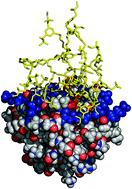Artificial protein sensors
Abstract
Protein recognition by synthetic molecules is a challenging endeavour, since these materials must bind to a large relatively flat surface domain and recognize a unique distribution of amino acid residues of varying charge, size and shape. The most promising routes involve specific metal coordination,


 Please wait while we load your content...
Please wait while we load your content...